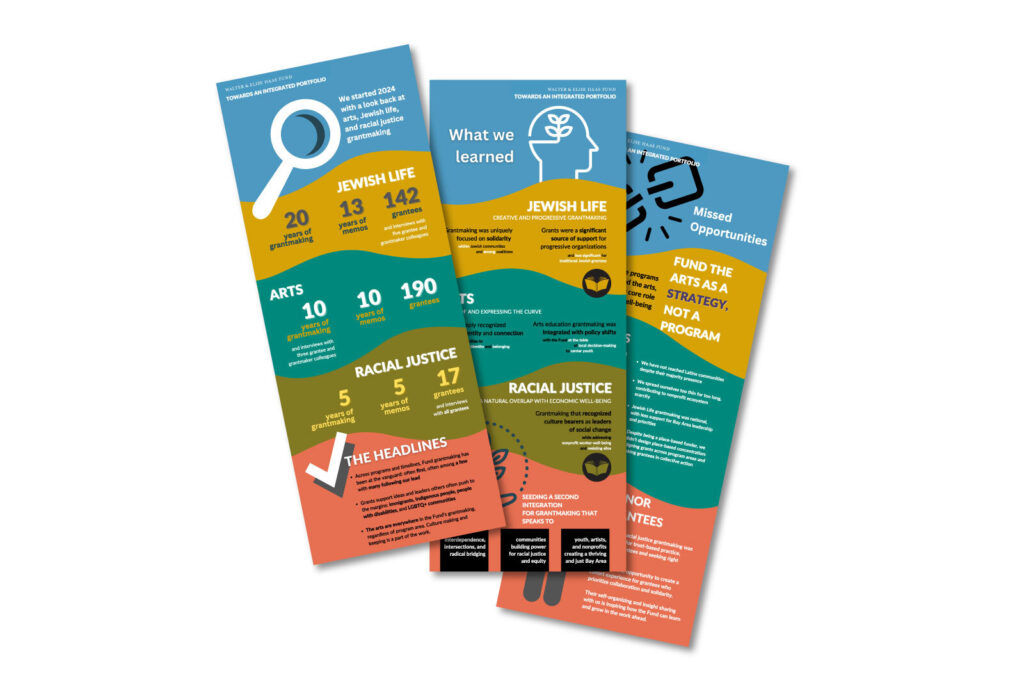This year we’ve been talking with grantees, community, and our board of directors to inform a redesign of our grantmaking in the arts, Jewish life, racial justice, and our interest in disaster preparedness and climate resilience. What drives this shift in our grantmaking is our commitment to move from silos to integration: we want to work in more holistic ways (and we talk more about that here).
We know that when funders engage in “shifts” there is speculation, uncertainty, and financial repercussions for grantees. People at the Fund itself feel these challenges. By intention, we are meeting this moment with trust-based practice, inclusion, space for reflection, and transparency.
Look Back to Look Forward: Portfolio Reviews
Starting in January, the Fund engaged consultants to synthesize learnings from the Fund’s grantmaking in arts, Jewish life, and racial justice. This review looked back 20 years to 349 grantees and $70M in grants. Consultants dug into the data, grantee reports, and board memos. They interviewed grantees. They synthesized their findings to help us see what they found in past grantmaking, and what they recommended we pull forward into the Fund’s future grantmaking.
The headlines:
- Across programs and timelines, Fund grantmaking has been at the vanguard: often first, often among a few with many following our lead
- Fund grants consistently supported ideas and leaders others often pushed to the margins: immigrants, Indigenous people, people with disabilities, and LGBTQ+ communities
- The arts are everywhere in the Fund’s grantmaking, regardless of “program area.” Culture making and keeping is a part of the work.
Explore our learning, a-ha’s, and our roadmap in these infographics.
Planting the seeds
In March, we shared our findings with trustees, realizing together that we could seed an integration for grantmaking that speaks to
- Interdependence, intersections, and radical bridging
- Communities building power for racial justice and equity
- Youth, artists, and nonprofits creating a thriving and just Bay Area
We began to understand these elements as an early definition of community well-being, a complement to our 2023 programmatic launch of economic-well-being.
Hearing from Community
In May we partnered with another consultant to engage our grantee community with these seed ideas. Consistent with our commitment to valuing community voice, we wanted to create safe, accessible spaces to hear community perspectives, needs, and aspirations. Over 50 people participated in key informant interviews, four focus groups composed of grantees representing each program area, and one focus group composed of youth aged 18 to 24. We asked what community well-being looks and feels like, explored its components, and what must be present for the Bay Area to have well-being. Also, we worked with a consultant to learn from the experiences and wisdom of our Creative Work Fund grantees.
During this time Fund staff compiled data to better understand the state of the Bay Area quality of life and current challenges. We toured neighborhoods with local residents and reached out to our grantmaking peers to see how our work might align with or disrupt local and global trends.
How do grantees, community members, and local leaders define community well-being? Five key themes and motifs emerged again and again. For the Fund, they represent the most significant hopes, aspirations, and needs in our community today:
1. Acting Together
Acting together describes collective efforts of individuals who, through shared purpose and mutual support, unite to address common challenges and to enact shared values. By engaging civically and standing in solidarity, they create a stronger, more cohesive society, where each member’s voice and action contribute to the greater good. This concept highlights the power and necessity of collective action and collaboration in fostering a thriving community.
2. The Arts Are Essential
The arts provide a powerful means for expression, connection, and healing. They foster a sense of identity and belonging, encourage creativity, and bring people together, creating a shared cultural experience that strengthens the social fabric. Through the arts, communities can navigate challenges, celebrate their diversity, and envision brighter futures.
3. Claiming Space
Space, both in physical and social-emotional terms, represents hubs for connection, dialogue, and shared experiences, which are essential for building strong, resilient communities. By asserting and maintaining these spaces, communities can protect and share their cultural heritage, support social cohesion, and ensure that all members have a voice and presence.
4. Bridging Divides
An inclusive and equitable community requires mutual understanding and respect among different groups. By finding common ground and addressing differences constructively, a diverse society can leverage its variety of perspectives and strengths for the good of everyone. Creating unity in diversity enhances collective well-being and helps build a society where everyone feels valued and included.
5. Leader Wellness
The well-being of nonprofit leaders is important because it directly impacts the effectiveness and sustainability of the organizations they lead. When nonprofit leaders are healthy and balanced, they are better equipped to make sound decisions, inspire their teams, and advance their missions forward. Prioritizing their wellness helps prevent burnout, ensures long-term leadership stability, and ultimately enhances the positive impact they can have on the communities they serve.
Ahead
The Fund’s goal is to have our new grantmaking designed by the end of 2024. We’re hosting design conversations with our trustees, iterating our prototypes, and seeking community feedback. We’ll post updates as we go and welcome your comments on our work so far.


